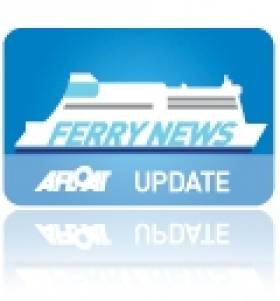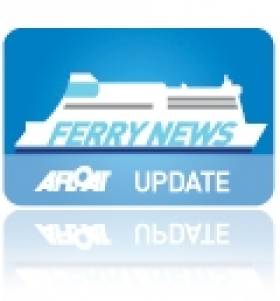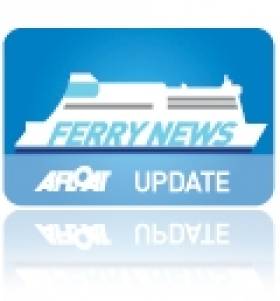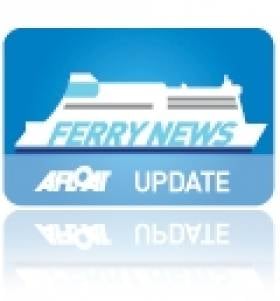Displaying items by tag: Isle of Man Steam Packet Company
Steam Packet to Offer Extra Liverpool-Manx Services in 2015
#ExtraLiverpoolServices – In 2015 there will be extra Liverpool services and increased availability of fare offers from the Isle of Man Steam Packet Company.
The Steam Packet announced that fast-ferry Manannan (which has returned to full power) will operate 48 additional seasonal Liverpool sailings next year.
The schedule also includes extra year-round services to Heysham, as well as winter services to Birkenhead operated by ro-pax Ben-my-Chree and seasonal services to Belfast and Dublin.
Foot passenger fares will remain the same for 2015, starting from £18 each way, and special offers for a car and two passengers start from £65 each way.
The summer Kids Go Free offer and Steam Packet Holidays-organised Day Trips will also return for next year. For the latest offers and to book for sailings in 2015 visit: www.steam-packet.com
Manx Fast-Ferry Sailings Operate On Reduced Engines
#FastFerryRepairs - Following the planned withdrawal of Manx fast-ferry Manannan from Liverpool-Douglas service last Wednesday afternoon (6 Aug) as previously reported, it has emerged that it will take longer than anticipated to complete repairs to a damaged engine of the craft.
According to operators, Isle of Man Steam Packet, the Manannan has been running on three engines since a crankshaft failed. In the interim period the affected engine has been fully disassembled and the failed crankshaft has been removed.
Precautionary checks on the engine block, necessary before the crankshaft can be replaced and the engine rebuilt, have revealed more extensive damage than first expected.
It was hoped that the commitment and careful scheduling of additional resources over the next fortnight would allow repairs to be completed while Manannan was in port overnight. The intention was to ensure no further sailings would be affected and the vessel would be back to full power for the Isle of Man Festival of Motorcycling.
However, because of the detailed inspection findings, Manannan will continue to operate on three engines during the Festival of Motorcycling, meaning journey times will be slightly longer than advertised. To read more click this LINK and for latest information on all sailings, click HERE.
Travel Back in Time to 'Tynwald' the World's Oldest Parliament Established by the Vikings
#TimeTravelTynwald: - Following the recent Round Island Sunset Cruise, the Isle of Man Steam Packet is operating an overnight Douglas-Dublin round trip this weekend in advance of Tynwald Day, writes Jehan Ashmore.
The ro-pax Ben-My-Chree, the company's largest vessel which normally serves the main Manx link between Douglas and Heysham, England will be on the seasonal service to Dublin, departing the Irish capital at 01:00 on Sunday (6 June) and arriving Douglas at 05:45 that morning.
This year's Tynwald Day ceremony is to be held on the following day (Monday 7 July). The Isle of Man's parliament, 'Tynwald' is the world's oldest continuous parliament that was established by the Vikings.
The parliament forms part of the island's unique 10,000 year heritage and Tynwald Day will be celebrated with a fair and a market. More importantly a traditional ceremony is also to be held on the ancient site of Tynwald Hill.
Ben-My-Chree which occasional operates Dublin-Douglas sailings are also maintained by fast-ferry Manannan. The vehicle-carrying catamaran craft also serves Douglas to Belfast, which too is seasonal operated. In addition she runs regular crossings between the Manx capital and Liverpool. For ferry website, click HERE.
Scenery or Steam Packet Ferry Front Cover Brochure Photo Competition
#PhotoCompetition – Photographers' look-out!... as the hunt is on for the perfect photograph to appear on the front cover of the Isle of Man Steam Packet Company's 2014 brochure.
The competition invites people to submit their photos showing the beauty of the Isle of Man or featuring the company's vessels the ferry ro-pax Ben-my-Chree and fast-craft Manannan.
Budding photographers can post their entries on the Steam Pacjet's company's facebook page, where people can also vote for their favourites.
The contest closes on 31 October, one of the entries could be selected to appear on the cover of the 2014 brochure.
Visitors to the Facebook page can also help choose the winner by voting on the entries. Full details, as well as terms and conditions, are available from the this facebook link.
Damaged Manx Ferry Returns to Service
#ManxFerry – The main ferry serving the Isle of Man has returned to service following contact with a pier while berthing at the start of this month in Douglas Harbour.
Repairs were made to Ben-my-Chree and she has since returned to operating a normal service between the Manx capital and Heysham.
The ro-pax ferry suffered damage four metres above her waterline after colliding with a berthing fender while docking at the linkspan at berth No. 5 along the King Edward Pier.
Manx-Mersey Route Reopens for Winter Season
#MANX FERRY – Sailings between the Isle of Man and Merseyside resumed service once again for the winter season, writes Jehan Ashmore.
The Isle of Man Steam Packet Co.'s ro-pax Ben-My-Chree started Douglas-Liverpool (Birkenhead) sailings this month and the vessel will also continue to operate services on her regular Douglas-Heysham route.
Crossing time from Birkenhead's Twelve Quays Ferry Terminal to the Manx capital take 4 hours 15 minutes. For sailings schedules of both routes click HERE.
Wind-Farm Proposal Requires No Isle of Man Shipping Re-routing
#MANX FERRY – A proposed extension to an offshore wind farm off Cumbria on the north-west coast of England will not require any re-routing of Isle of Man shipping lanes, say the developers.
A Dong Energy spokesman said the 200-turbine development would not, in isolation, present any problems. The extension is being proposed to a 102-turbine wind farm off Walney Island. The facility is said to be one of the largest in the world and in which opened earlier this year.
Emily Marshall, from Dong Energy, said: "We can confirm that re-routing shipping lanes will not be an issue." She added: "However, the Irish Sea is getting busier with other projects in the development phase and we are undertaking cumulative impact assessments for people who are concerned, with regards to commercial interests."
Extra Freight Ferry Chartered for Manx TT Races
#MANX TT RACES FERRY NEWS – According to BBC News, an additional ro-ro freight-ferry has been chartered from Seatruck Ferries by the Isle of Man Steam Packet Company in order to cope with demand during the TT races.
More than 11,200 motorbikes are already booked to arrive in Douglas during race fortnight, which begins on Monday. The number is the highest for a decade with the exception of the event's centenary in 2007.
The chartered vessel is the Arrow (1998/7,606grt), which will assist in peak periods. The 122m long vessel can transport around 1,000 metres of freight and is the sister ship of Helliar, which covered during the island's passenger ferry Ben-my-Chree's scheduled dry dock.
Steam Packet Company Chief Executive Mark Woodward said: "While MV Arrow doesn't bring any additional passenger space, we have already made provision for 43,000 extra seats scheduled over the TT period."
"This second chartered vessel provides additional operational resilience during the busiest time of the year."
Plans for Wind-Farms Won’t Affect Manx Ferry Operator
#MANX FERRY – The IOM Today reports that the Manx Government is drawing up plans to ensure that any wind-farms built within the waters off the island would not affect ferry routes.
Work on the Isle of Man Marine Plan is under way and the Department of Environment, Food and Agriculture's director of environment Martin Hall said it was important it was completed in a 'timely manner'.
One of the plan's objectives would be to identify current activities in Manx waters and safeguard their ongoing use. Mapping the location of navigation corridors, important natural areas and pipelines/cables will enable the island to identify potential wind farm sites that will not adversely affect current uses of the Manx marine environment, including ferry routes and fishing.
The comments come following criticism from the Isle of Man Steam Packet Company over Centrica's plans for a wind farm in the Irish Sea, outside Manx waters. The Steam Packet says that Centrica plans to develop in the path of two routes: Douglas-Liverpool and Douglas-Heysham, in spite of complaints from the ferry operator. For much more on this story click HERE.
Bank Holiday Marks Start of Manx Sailings
#ISLE OF MAN FERRY – This Easter bank holiday weekend marks the start of the Isle of Man Steam Packet Co.'s seasonal-only Dublin-Douglas ferry service, with a sailing scheduled to depart this evening, writes Jehan Ashmore.
The wave-piercing catamaran fastcraft Manannan had departed the Manx capital this afternoon to form the inaugural outbound sailing, which takes nearly three hours to complete. The 96m fastcraft is the largest of her type in the Irish Sea and she was built by InCAT in Hobart, Tasmania. She also maintains sailings on the Douglas to Belfast and Liverpool routes.
For sailing timetables across the network of routes to the Isle of Man click HERE and for a guide about the fastcraft and conventional ferry Ben-My-Chree click this LINK.






































































